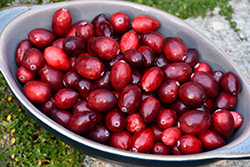Height: 6 inches
Spread: 6 feet
Sunlight:
![]()
Hardiness Zone: 3a
Other Names: Large Cranberry
Description:
A native bog groundcover suited to swamps and wet shorelines; small, glossy leaves backdrop nodding, white to pink flowers in spring to early summer; flowers are followed by plump, red to dark purple edible berries that have a tart flavor
Edible Qualities
American Cranberry is a small shrub that is typically grown for its edible qualities, although it does have ornamental merits as well. It produces large clusters of red round berries with purple overtones which are usually ready for picking from mid summer to early fall. The berries have a tart taste and a firm texture.
The berries are most often used in the following ways:
- Cooking
- Preserves
- Juice-Making
- Canning
- Freezing
- Sauces
Features & Attributes
American Cranberry features dainty nodding white recurved flowers with shell pink overtones hanging below the branches in mid spring. It has dark green evergreen foliage which emerges coppery-bronze in spring. The small glossy oval leaves turn an outstanding burgundy in the fall, which persists throughout the winter. It features an abundance of magnificent red berries with purple overtones from mid summer to early winter.
This is a multi-stemmed evergreen shrub with a spreading, ground-hugging habit of growth. Its relatively fine texture sets it apart from other landscape plants with less refined foliage. This is a relatively low maintenance plant, and usually looks its best without pruning, although it will tolerate pruning. It is a good choice for attracting birds, bees and butterflies to your yard, but is not particularly attractive to deer who tend to leave it alone in favor of tastier treats. Gardeners should be aware of the following characteristic(s) that may warrant special consideration;
- Insects
- Disease
Aside from its primary use as an edible, American Cranberry is sutiable for the following landscape applications;
- Mass Planting
- Groundcover
- Container Planting
- Bog Gardens
Planting & Growing
American Cranberry will grow to be only 6 inches tall at maturity, with a spread of 6 feet. It tends to fill out right to the ground and therefore doesn't necessarily require facer plants in front. It grows at a medium rate, and under ideal conditions can be expected to live for approximately 30 years. This is a self-pollinating variety, so it doesn't require a second plant nearby to set fruit.
This shrub is quite ornamental as well as edible, and is as much at home in a landscape or flower garden as it is in a designated edibles garden. It should only be grown in full sunlight. It prefers to grow in moist to wet soil, and will even tolerate some standing water. This plant should be periodically fertilized throughout the active growing season with a specially-formulated acidic fertilizer. It is very fussy about its soil conditions and must have sandy, acidic soils to ensure success, and is subject to chlorosis (yellowing) of the foliage in alkaline soils. It is quite intolerant of urban pollution, therefore inner city or urban streetside plantings are best avoided, and will benefit from being planted in a relatively sheltered location. Consider covering it with a thick layer of mulch in winter to protect it in exposed locations or colder microclimates. This species is native to parts of North America.
American Cranberry is a good choice for the edible garden, but it is also well-suited for use in outdoor pots and containers. Because of its spreading habit of growth, it is ideally suited for use as a 'spiller' in the 'spiller-thriller-filler' container combination; plant it near the edges where it can spill gracefully over the pot. Note that when grown in a container, it may not perform exactly as indicated on the tag - this is to be expected. Also note that when growing plants in outdoor containers and baskets, they may require more frequent waterings than they would in the yard or garden.

